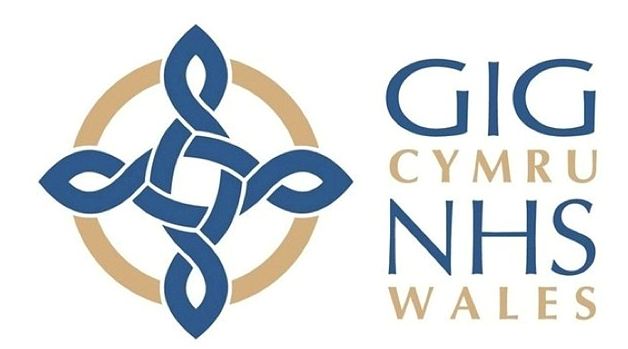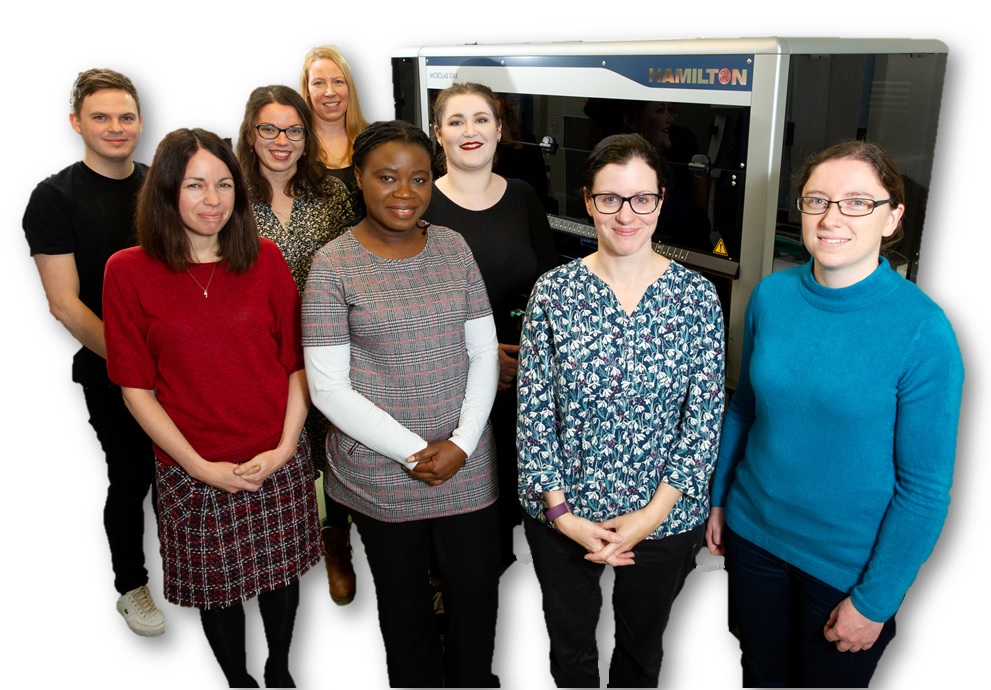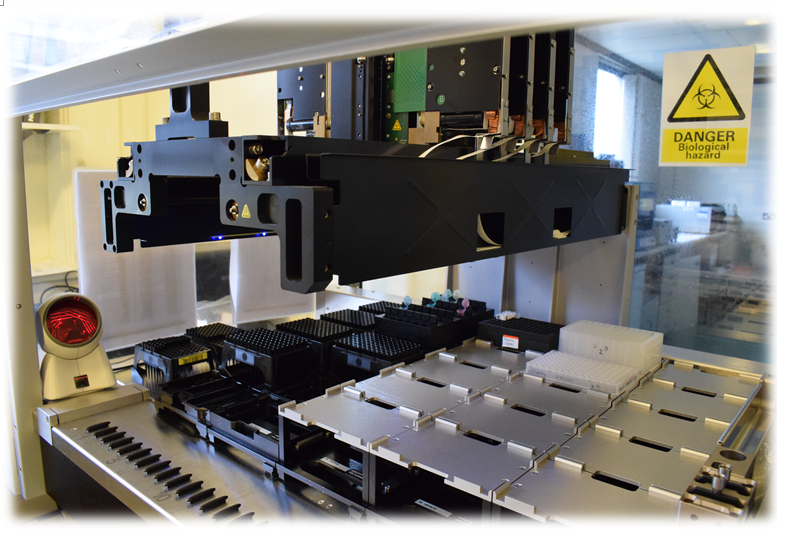 The Technical Section of the All Wales Genomics Laboratory supports and manages the day-to-day running of the centralised specimen processing protocols and services, for the delivery of the portfolio of genetic testing offered by the Cancer and Constitutional Sections.
The Technical Section of the All Wales Genomics Laboratory supports and manages the day-to-day running of the centralised specimen processing protocols and services, for the delivery of the portfolio of genetic testing offered by the Cancer and Constitutional Sections.
The section is managed by Justyna Tull, the Head of Technical Programme and is comprised of: Admin & Clerical Officers, Medical Technical Officers, Associate Practitioners, Genetic Technologists, Lead Genetic Technologists and Senior Genetic Technologists that work across 5 technical hubs:
- Specimen Reception & Extraction
- PCR & MLPA
- Culturing & FISH
- Genotyping & Sanger Sequencing
- Next Generation Sequencing
The Technical Section is responsible for the provision of a wide range of cytogenetic and molecular techniques for the diagnosis of genetic conditions. It is also involved in the processing only type of activities, such as sample storage for a number of clinical trials and research projects.
Please contact the laboratory if you require any assistance with specific protocols, access to the equipment or any of the technical services.
DNA and RNA Extraction
The laboratory extracts DNA from whole blood, solid tissues, prenatal samples (amniotic fluid and CVS) or FFPE tissue. The Hamilton Chemagic Star system is used for extraction of high volume blood samples (at least 2mls of blood is needed for a successful extraction). This is a fully automated liquid handling and DNA extraction robot that can extract up to 48 samples in a batch. The Promega Maxwell RSC system is used for low volume bloods, tissues or FFPE samples. This is a semi-automated system used for extraction of DNA, following various pre-processing steps depending on the type of sample/ tissue.
The laboratory also receives a growing number of blood samples for the separation of plasma and buffy coat. These are received from cancer patients for diagnostic tests as well as storage for a number of clinical trials and from early pregnancy for the antenatal NIPT testing. It can then extract ctDNA from cancer patient plasma and a cfDNA for antenatal NIPT testing, using a Qiagen QiaVac instrument and extraction methods.
The laboratory extracts RNA from whole blood, fresh tissue and FFPE tissue, using the Promega Maxwell RSC system.
The quantity and quality of extracted DNA and RNA samples is measured using either a Nanodrop spectrophotometer or a Qubit Fluorometer.
The laboratory offers an extraction and banking service, so that the patient sample is stored safely, should it be needed for any future testing. This is available for DNA or RNA extraction and for separation of plasma or buffy coat from a whole blood sample.
Culturing and FISH
The Culturing and FISH team process a range of samples for culturing. This includes culturing of post-natal samples e.g. blood and bone marrow and pre-natal samples e.g. amniotic fluid and CVS. The cultured cells can be spread onto slides for either karyotyping or FISH analysis. In addition to culturing of bone marrow samples for various haematological malignancy disorders separation of plasma cells is performed for FISH analysis. The RoboSep™-S instrument (Stemcell Technologies) is used for the automated myeloma plasma cell separation. The team process a high quantity and variety of FISH tests on a range of samples which also includes the de-paraffinisation and pre-treatment of FFPE samples for FISH analysis.
PCR and Genotyping Services
The laboratory performs a wide range of different types of PCR amplification, for gene sequencing or targeted genotyping. The two Hamilton Starlet robots are used for high throughput automated set up of PCRs for Sanger sequencing using M13 tagged PCR primers.
The other types of PCR set up manually in the laboratory include:
- QF-PCR - for rapid aneuploidy and maternal cell contamination testing, using Quantitative Fluorescence PCR analysis of short tandem repeats; the laboratory uses in-house validated kits
Real time PCR – targeted real-time testing using allelic discrimination assays and quantitative assays that are run on the ThermoFisher Step One instrument
- ddPCR - use of the Bio-Rad QX200 droplet generator and the QX200 droplet reader for droplet digital PCR mutation detection assays, giving absolute quantification of target DNA in a digital form; the laboratory performs a selection of tests for cancer patients (lung and colorectal)
- TP PCR - Triplet Primed PCR is used to visualise larger expansions which cannot be amplified by standard PCR, and also to confirm the larger repeats seen with the PCR amplification. This is used to detect triplet repeat expansions in different disorders e.g. Friedreichs Ataxia, Spinocerebellar ataxia, Fragile X
- Multiplex fluorescent PCRs using commercially available kits for CF50 and DPYD testing
The genotyping services offered by the laboratory include:
- MLPA – a wide range of Multiplex Ligation-dependent Probe Amplification kits, commercially available from MRC Holland, are used routinely in the laboratory for standalone testing (for diseases such as DMD and SMA) or as dosage analysis complimentary to the screening testing (by Sanger sequencing or Next Generation Sequencing)
- MSI – Microsatellite Instability testing is performed in the laboratory for colorectal cancer patients using the the Promega MSI Analysis System and for chimerism (bone marrow transplant monitoring) service using the AmpFℓSTR Identifiler kit
The laboratory runs a centralised genotyping service where all the fluorescent PCR products are compiled together into a 96 well format and analysed on a 3730 genetic analyser, using the G5 Dye Set predominantly.
PCR products can be run on an agarose or polyacrylamide gel (gel electrophoresis), as relevant to the application.
Sequencing (incl. Next Generation Sequencing)
The laboratory performs different types of sequencing for the detection of mutations and gene aberrations:
Pyrosequencing
The method of DNA sequencing based on the "sequencing by synthesis" principle, in which the sequencing is performed by detecting the nucleotide incorporated by a DNA polymerase, is used in the laboratory for the detection of SNP hotspots and methylation profiles, following bisulphite conversion of the DNA sample. These are done using the Qiagen Q48 AutoPrep instrument. Pyrosequencing is a rapid service used for testing, such as for personalised cancer treatment where a fast turnaround time is crucial to patient care management.
Sanger Sequencing -
Sanger sequencing is a method of DNA sequencing first commercialized by Applied Biosystems, based on the selective incorporation of chain-terminating dideoxynucleotides by DNA polymerase during in vitro DNA replication (Big Dye v1.1 Terminator technology). The sequencing operates as a centralised service, using M13 tagged PCR products and M13 universal sequencing primers and is set up in a 384 well format, to allow for high throughput of samples to be processed in a timely manner (including 3 calendar day prenatal referrals).The Hamilton Starlet liquid handling robot, with a 96 pipetting head, is used for the fully automated clean-up of PCR products (Ampure bead technology), compilation of 96 well plates into a 384 well format, set up of the Big Dye sequencing reaction, followed by a clean-up of sequencing products (CleanSEQ bead technology), prior to analysis.

The laboratory owns 2 capillary electrophoresis genetic analyzers: 3730 with a 48 capillary head and 3730XL with a 96 capillary head, which are used for sequencing and genotyping analysis.
Next Generation Sequencing is a rapidly expanding section of the laboratory. With the fast developing capacity, it is becoming a technology of choice within the clinical and genomics diagnostics.NGS refers to large-scale DNA sequencing technology that allows for querying the entire genome (whole genome), the exons within all known genes (whole exome), or only exons of selected genes (target panel).
The laboratory performs a number of targeted sequencing panels and library preparation protocols for the diagnosis of inherited disorders as well as somatic and de novo conditions. These protocols include: Qiagen GeneRead, Illumina TruSight One/ TruSight Cancer/ TruSight Myeloid/ VeriSeq NIPT system v2/ Flex, Oxford Gene Technology SureSeq, Roche Kapa HyperPlus & SeqCap. The launch of the rapid whole genome sequencing service for the acutely unwell babies is the most recent success of the laboratory. This is set up using the Illumina Flex protocol.
AWMGL also has two pre-PCR and two post-PCR Hamilton STAR robots used for the automated preparation and purification of libraries, prior to sequencing. We are proud to own the following Illumina sequencing systems:
- 2 x MiSeq
- 2 x NextSeq 550
- 2 x NovaSeq 6000.
Array CGH
Array CGH is an ultra-high resolution way of objectively and quantitatively detecting whether a patient’s DNA has losses (deletions) or gains (duplications, triplications etc.) which are pathogenic and therefore explain their clinical problems.
Array CGH analysis has been the first-line test to detect chromosomal imbalances in specific cohort of patients in the laboratory since October 2013. The patients include those presenting with developmental delay, learning disability and/ or multiple congenital abnormalities, and as such aCGH replaced the karyotyping analysis.
Array CGH can detect genomic deletions or duplications with far greater sensitivity (>100 times) than can be achieved by chromosome analysis using light microscopy.
The laboratory uses an array platform that utilises 60,000 oligonucleotide probes in multiples of eight arrays per slide (8x60k format) provided by Oxford Gene Technology (OGT), the CytoSure Constitutional v3 kit.
Agilent microarray scanner is used to analyse the arrays.



